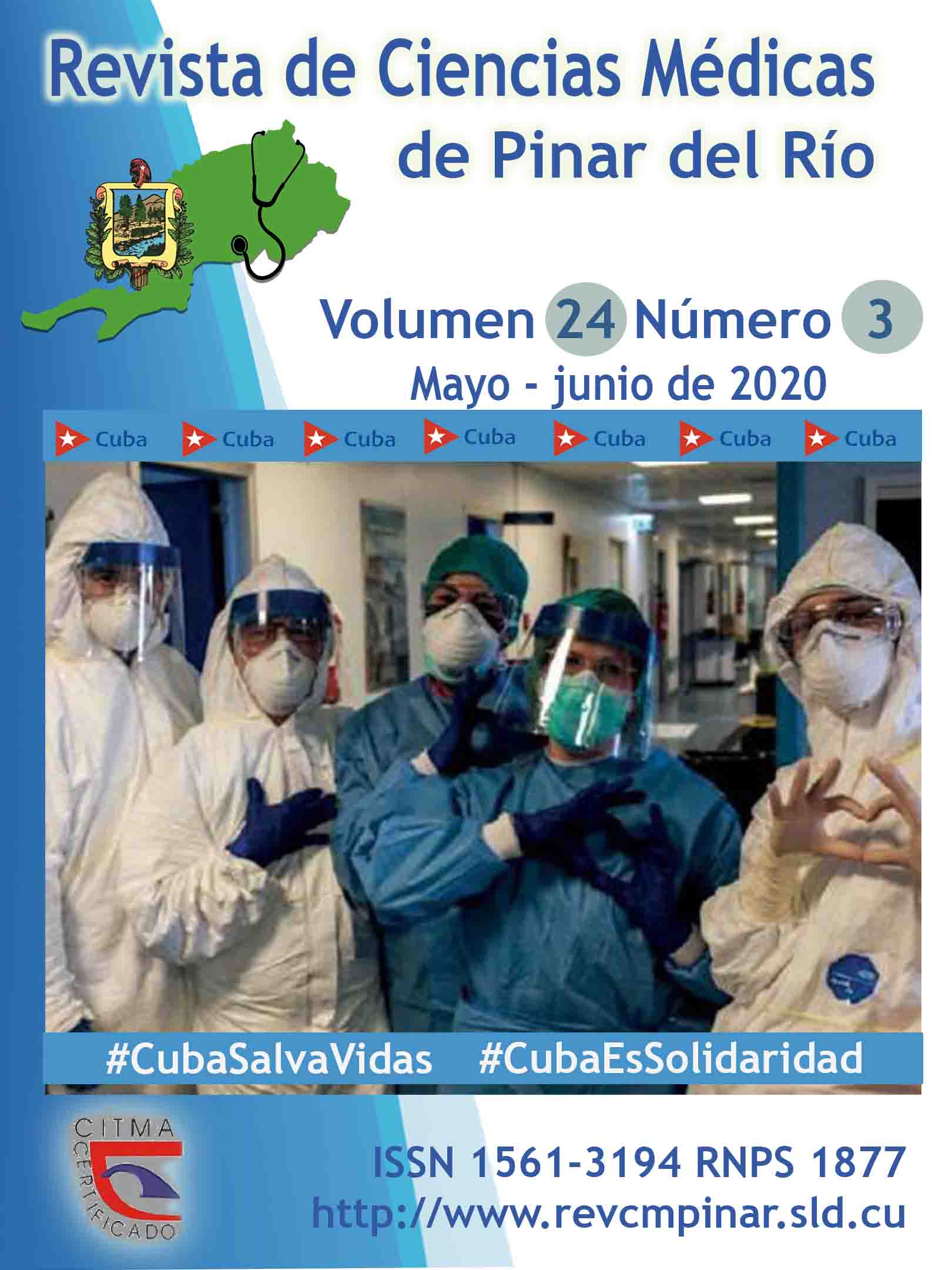Fascitis necrotizante en región anterior del cuello
Keywords:
Cuello, Fascitis Necrotizante, Cáncer De Laringe, Desbridamiento, Traqueostomía.Abstract
Introducción: la fascitis necrotizante corresponde a una infección bacteriana de los tejidos blandos, caracterizada por necrosis difusa y rápidamente progresiva del tejido celular subcutáneo y sistema músculo aponeurótico, acompañado de un acentuado compromiso séptico sistémico.
Presentación del caso: se presenta el caso de un paciente de 66 años de edad, masculino, negro, con antecedentes de una neoplasia de laringe sin diagnóstico histológico, que fue recibido en el cuerpo de guardia del servicio de Otorrinolaringología del Hospital Abel Santamaría Cuadrado, por presentar un cuadro de gran toma del estado general, fiebre, disnea inspiratoria, estridor; al examen físico se encontró lesión ulcero necrótica de gran extensión en la región anterior del cuello. Se estableció el diagnóstico de una fascitis necrotizante del cuello y una neoplasia de laringe causante de un síndrome disneico laríngeo. Se procedió a realizar necrectomía y traqueostomía e ingreso del paciente.
Conclusiones: la fascitis necrotizante de la región anterior del cuello a punto de partida de una neoplasia laríngea es una infección poco común, rápidamente progresiva y de difícil diagnóstico en estadío temprano.
Downloads
References
1. Peyrí J, Lleonart M, Grupo español del Estudio SEBDERM. Perfil clínico, terapéutico y calidad de vida de los pacientes con dermatitis seborreica. Actas Dermosifiliogr [Internet]. 2007 [citado 10/11/2019]; 98: 476-482. Disponible en: https://www.sciencedirect.com/science/article/abs/pii/S0001731007701114
2. Bielsa Marsol I. Eccemas (II). Dermatitis seborreica y atópica. En: Ferrándiz Foraster C. Dermatología clínica. 4ta ed. Barcelona: Elsevier España; 2014. 99-108.
3. Tello-Ibáñez OO, Fabián-San Miguel G, Arenas R, Guevara-Cervantes JF, Fernández R. Dermatitis seborreica y Malassezia. Relación en pacientes con diabetes mellitus tipo 2. Med Int Méx [Internet]. 2016 [citado 12/11/2019]; 32(2): 185-189. Disponible en: https://www.medigraphic.com/pdfs/medintmex/mim-2016/mim162e.pdf
4. Calderón-Komáromy A, Borbujo J, Freites-Martínez A. Dermatitis seborreica. FMC [Internet]. 2014 [citado 10/11/2019]; 21(1): 33-37. Disponible en: https://www.fmc.es/es-dermatitis-seborreica-articulo-S1134207214706905
5. Bonifaz A, Araiza J, Baños-Segura C, Ponce-Olivera RM. Estudio comparativo de dos esquemas de tratamiento para dermatitis seborreica capitis con champú de ciclopiroxolamina/piritionato de zinc/keluamida (CPO/PZ/K). DermatologíaCMQ [Internet]. 2015 [citado 12/11/2019]; 13(3): 188-193. Disponible en: https://www.medigraphic.com/pdfs/cosmetica/dcm-2015/dcm153b.pdf
6. Torres E, Arenas R, Atoche-Diéguez C. Infecciones causadas por el género Malassezia. Med Cutan Iber Lat Am [Internet]. 2008 [citado 12/11/2019]; 36(6): 265-284. Disponible en: http://www.medcutan-ila.org/images%5Cpdf%5Carticulos/2008/6/pdf/mc366b.pdf
7. Díaz Egüez AE. Relación entre dermatitis seborreica y nivel de estrés en los pacientes adultos del Centro de la Piel (CEPI) de la Ciudad de Quito [tesis]. Quito; Pontificia Universidad Católica del Ecuador; 2014.
8. Medina Castillo DE. Dermatitis seborreica: una revisión. Dermatología CMQ [Internet]. 2014 [citado 10/11/2019]; 12(2): 135-141. Disponible en: https://www.medigraphic.com/pdfs/cosmetica/dcm-2014/dcm142l.pdf
9. Plewig G, Jansen T. Dermatitis seborreica. En: Wolff K, Goldsmith LA, Katz SI, Gilchrest BA, Paller AS, Leffell DJ. Dermatología en Medicina General. 7ma ed. Buenos Aires: Editorial Médica Panamericana; 2008. 219-225.
10. García-López R. Composición e inmunología de la leche humana. Acta Pediatr Mex [Internet]. 2011 [citado 14/11/2019]; 32(4): 223-230. Disponible en: https://www.redalyc.org/pdf/4236/423640330006.pdf
11. Vásquez-Garibay EM. Primer año de vida. Leche humana y sucedáneos de la leche humana. Gac Med Mex [Internet]. 2016 [citado 14/11/2019]; 152 Suppl 1: 13-21. Disponible en: https://www.anmm.org.mx/GMM/2016/s1/GMM_152_2016_S1_013-021.pdf
12. Brahm P, Valdés V. Beneficios de la lactancia materna y riesgos de no amamantar. Rev Chil Pediatr [Internet]. 2017 [citado 14/11/2019]; 88(1): 7-14. Disponible en: http://dx.doi.org/10.4067/S0370-41062017000100001
13. Calderón P, Rojas C, Apt W, Castillo D. Miasis cutánea por Cochliomyia hominivorax asociada a dermatitis seborreica. Rev Med Chile [Internet]. 2017 [citado 14/11/2019]; 145: 250-254. Disponible en: https://scielo.conicyt.cl/pdf/rmc/v145n2/art13.pdf
Downloads
Published
How to Cite
Issue
Section
License
Authors who have publications with this journal agree to the following terms: Authors will retain their copyrights and grant the journal the right of first publication of their work, which will be publication of their work, which will be simultaneously subject to the Creative Commons Attribution License (CC-BY-NC 4.0) that allows third parties to share the work as long as its author and first publication in this journal are indicated.
Authors may adopt other non-exclusive license agreements for distribution of the published version of the work (e.g.: deposit it in an institutional telematic archive or publish it in a volume). Likewise, and according to the recommendations of the Medical Sciences Editorial (ECIMED), authors must declare in each article their contribution according to the CRediT taxonomy (contributor roles). This taxonomy includes 14 roles, which can be used to represent the tasks typically performed by contributors in scientific academic production. It should be consulted in monograph) whenever initial publication in this journal is indicated. Authors are allowed and encouraged to disseminate their work through the Internet (e.g., in institutional telematic archives or on their web page) before and during the submission process, which may produce interesting exchanges and increase citations of the published work. (See The effect of open access). https://casrai.org/credit/



